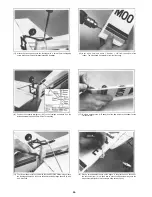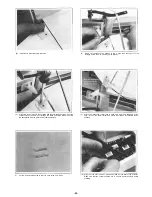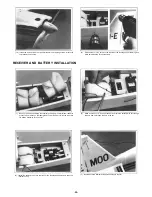
SERVO THROWS CENTER OF GRAVITY
The amount of throw that the control surfaces have is critical if you want a properly
responsive plane Measure the throws as shown above They should be
Balance the plane using the mark on the side of the fuselage It should balance at this
point See below
Each way
3/16"
Total
3/8"
Ailerons
Elevator 9/16" 1-18"
Rudder 1 3/8" 2 3/4"
If not, move the clevis to a different hole or use a larger servo horn
PRE-FLIGHT CHECK
1 Clean the dust dirt and oil off of the surface of the airplane
2 Check to make sure all nuts bolts and screws are securely fastened
3 Check all control surfaces to see if they are properly attached
4 Check the range of the radio system as the manufacturer recommends
5 Check that all controls move smoothly and in the proper directions
6 Check the level of charge in the transmitter and receiver batteries
7 Check that the area being used is free of obstacles and debris
8 Check the frequencies currently in use at the field and in your area
9 Check the level of the fuel tank to be sure it is full
10 Double check the radio operation
AFTER-FLIGHT MAINTENANCE
• Remove all excess fuel from the fuel tank, as this fuel can become jellylike
and cause clogging of fuel lines, as well as clogging the engine's carburetor
valves
• Always use after run oil in the engine to prevent corrosion
• Check and double check that the transmitter and receiver switches are
switched to the off positions
• Wipe off the excess oil that will collect on the wing and fuselage Use a
light duty cleaner to help cut through the oil
• Remove fresh fuel from the surface of the plane immediately, as different
brands can cause clouding of the surface
• Replace any bent marred or dinged props as they can fly apart at any time
when the engine is running
• Completely check the airplane for damage to the wings, landing gear,
covering and repair as needed before your next flight
REPAIR
If damage should occur wipe the broken area clean with a clean rag to remove all
debris Use epoxy glue to repair Do not use Cyanoacrylate adhesive near any foam
parts as it will deteriorate the foam
TRANSPORTING CHECKLIST
Before leaving for the flying field go through the checklist This will help prevent you
from forgetting to take things with you
Make sure radio batteries are all charged
Make sure the transmitter and receiver are on the same frequency
Glow plug clip and fully charged 1/12 volt battery
Fuel and fuel pump or fuel bulb
Extra props and prop wrench
Screw drivers knife pliers and wrenches
Epoxy and something to mix it on
Paper towels
Cleaner to remove residue on the plane
10 Extra glow plugs
11 Electric starter or chicken stick
CENTER OF GRAVITY (C.G)
The center of gravity is a very important aspect of setting up the airplane properly
It will control a large part of what type of flying characteristics your plane will have
If it s nose heavy the airplane will try to dive and the elevator will be sluggish to
respond to your control inputs If the plane is tail heavy the airplane will be very
sensitive to the elevator and possibly very uncontrollable The center of gravity
should be checked with an empty fuel tank to be accurate The range in which the
airplane should balance is marked with a black dot on the side of the fuselage
With standard radio equipment the plane may balance within this range If it does
not balance within this range, feel free to add weight to the nose or tail as you need
to obtain a proper C G
IMPORTANT SAFETY MEASURES
Receiver Battery
1 Always make sure the receiver battery pack is fully charged before flying
2 Wrap the receiver battery in 1/2"' soft foam rubber to protect it from engine
vibration and shock A rubberband may be used to hold the foam around the
battery pack It is also suggested to place the battery pack in a plastic bag to
protect it from fuel
3 If using NiCd batteries follow the instruction that came with your radio for
charging and care of the batteries
4 Before the first flight of the day check all the wires on the battery pack and
switch for corrosion or broken wires
5 Do a pre flight check (page 28) of your radio system each flying session
Receiver
1 Do not cut the receiver antenna This may affect the sensitivity of the receiver
2 Carefully wrap the receiver in foam and a plastic bag like the receiver battery
3 Make sure that all the servos are plugged into the correct receiver terminal
Servos
1 Make sure that all the control surfaces move smoothly without binding When
installing the push rods the servo must be able to move through its complete
range of rotation
2 If the servo buzzes when the transmitter stick is moved to its limit the servo
still has some movement left This can damage the servo and drain the battery
which may cause loss of control of the plane and a crash
FLIGHT SAFETY
• If this airplane happens to be your first radio controlled airplane we strongly
suggest that you ask a skilled pilot to help you fly it You should also suggest
to him to take the maiden flight to see what problems (if any) that need to be
worked out There will be enough to worry about on your first flight without
having to worry about whether or not it is properly set up
• Fly in an open field without any obstructions For example trees power lines
buildings crowds or people etc are obstacles that the plane may hit and
cause damage
• Fly the model at a reduced throttle until you get to know the flight character
istics
When adjusting the needle valve just prior to flight hold the plane at a 45°
• nose up attitude full open throttle and adjust the throttle for top performance
as the manufacturers instructions suggest
-26-



































